
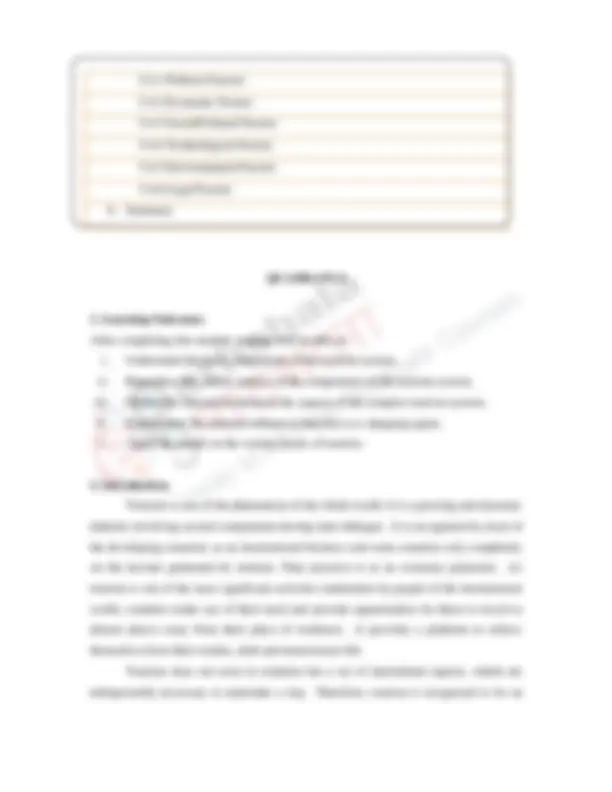
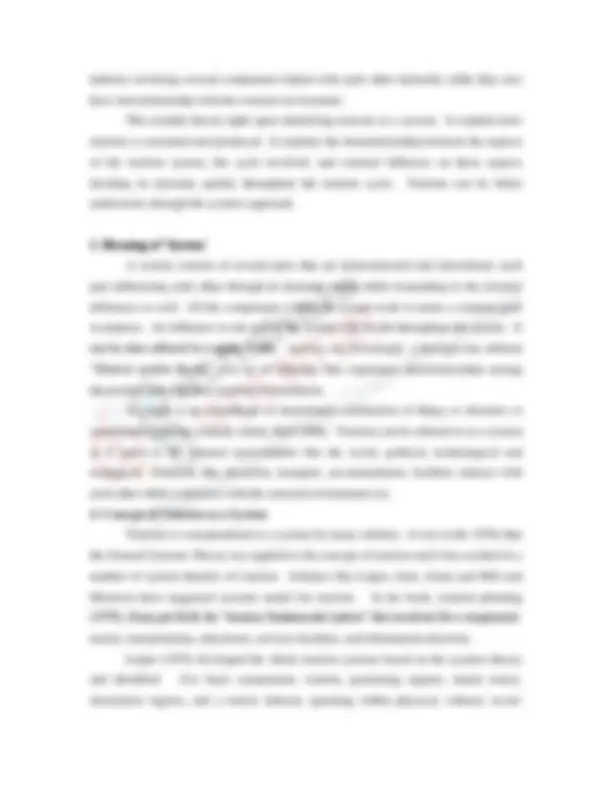
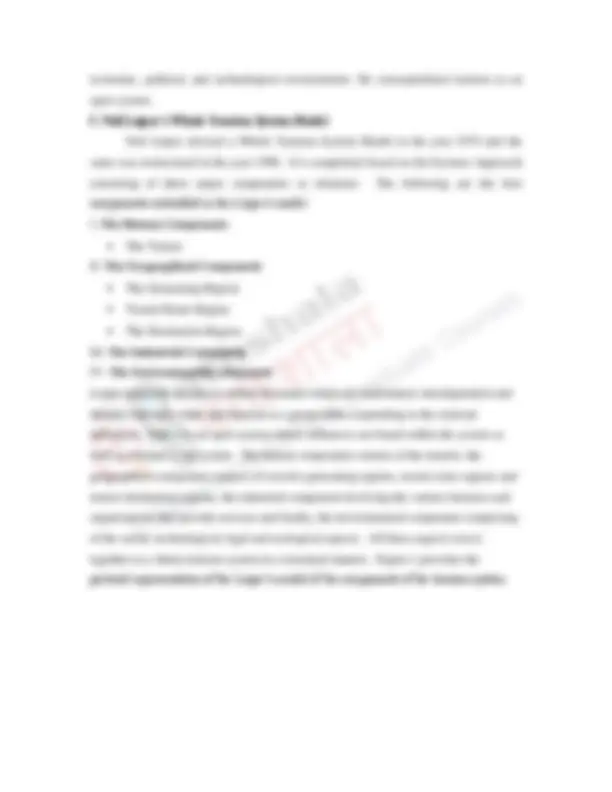
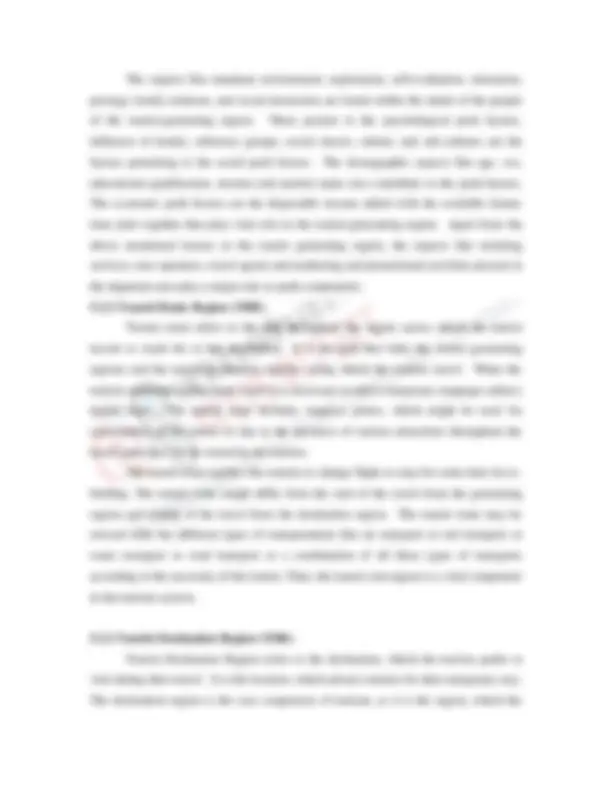
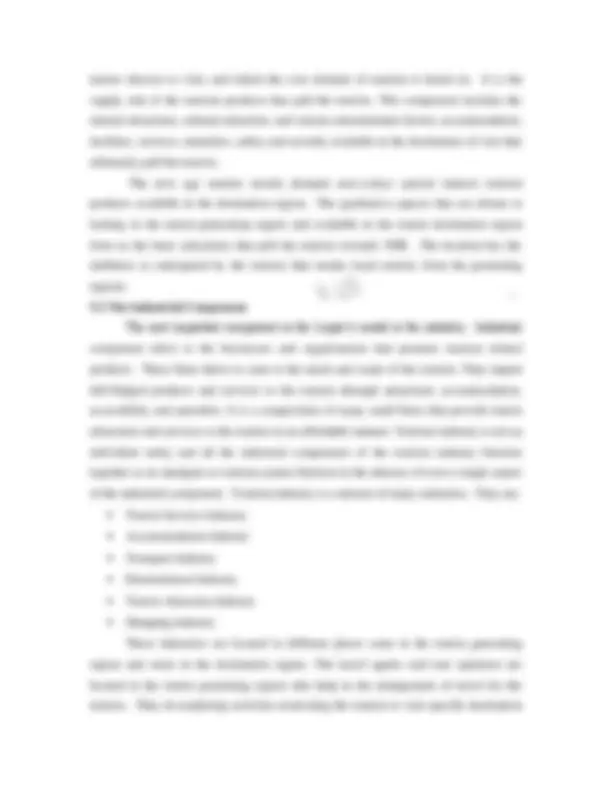

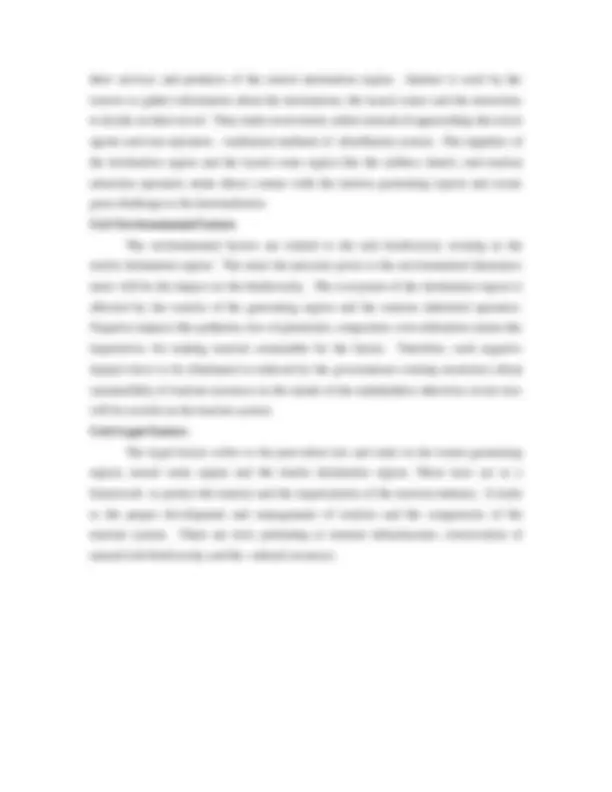
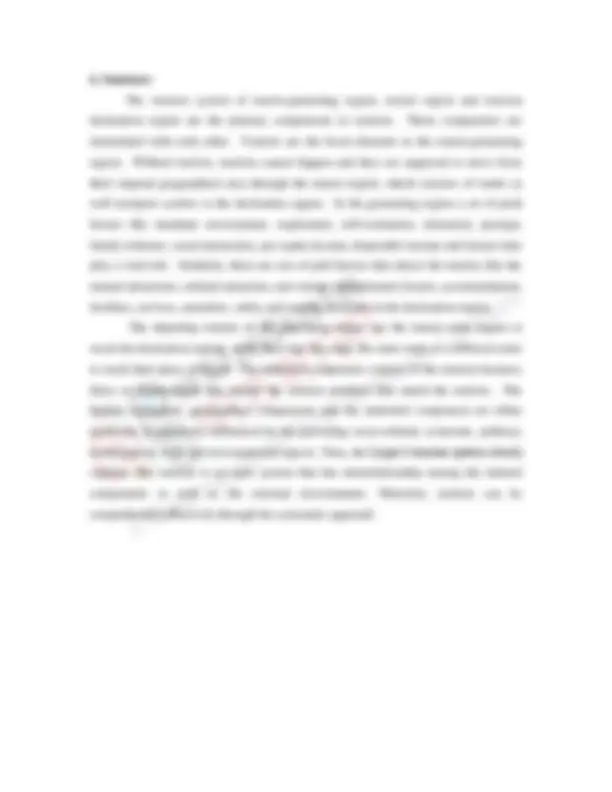


Study with the several resources on Docsity

Earn points by helping other students or get them with a premium plan


Prepare for your exams
Study with the several resources on Docsity

Earn points to download
Earn points by helping other students or get them with a premium plan
Community
Ask the community for help and clear up your study doubts
Discover the best universities in your country according to Docsity users
Free resources
Download our free guides on studying techniques, anxiety management strategies, and thesis advice from Docsity tutors
An in-depth analysis of the tourism system, focusing on its components and their interrelationships. the concept of tourism as a system, the human component (tourists and their motivations), the industrial component (accommodation, transport, and attraction industries), and the environmental component (economic, social, and legal factors). The document also discusses the impact of external influences on the tourism system and applies the model to various forms of tourism.
What you will learn
Typology: Study notes
1 / 14

This page cannot be seen from the preview
Don't miss anything!









Principal Investigator Prof. S. P. Bansal Vice Chancellor, Indira Gandhi University, Rewari Co-Principal Investigator Dr. Prashant K. Gautam Director, UIHTM, Panjab University, Chandigarh Paper Coordinator Prof. Sampada Kumar Swain Amarkantak University ,M.P.
Content Writer Dr. C. Shanti Marie Assistant professor Department of Tourism, Government Arts College, Udumalpet
Content Reviewer Prof. Jayanta Kumar Parida Department of Commerce Utkal University, Bhubaneswar
Paper 01 : Tourism And Hospitality: Concept, Component, Status And Trends Historical Development of Tourism and Hospitality in the World Module 06 : Components of the Tourism System
Subject Name Tourism and Hospitality Paper Name Tourism and Hospitality: Concept, Component, Status and Trends Module Title Components of the Tourism System
Module Id Module No- Pre- Requisites Basic knowledge about Tourism Objectives To study the meaning of the tourism system and the components revolving around it Keywords Tourism, System, Components, Push & Pull factors, Environment
industry involving several components linked with each other internally while they also have interrelationship with the external environment. This module throws light upon identifying tourism as a system. It explains how tourism is consumed and produced. It explains the interrelationship between the aspects of the tourism system, the cycle involved, and external influence on these aspects deciding its dynamic quality throughout the tourism cycle. Tourism can be better understood, through the systems approach.
3. Meaning of ‘System’ A system consists of several parts that are interconnected and interrelated, each part influencing each other through its dynamic nature while responding to the external influences as well. All the components within the system work to attain a common goal or purpose. An influence in one part of the system will be felt throughout the system. It can be also referred to a spider’s web. Ludwig von Bertalanffy, a biologist has defined ‘ General system theory’ as a set of elements that experience interrelationship among themselves and with their external environments. A system is an assemblage or interrelated combination of things or elements or components forming a unitary whole (Hall 2008). Tourism can be referred to as a system as it reacts to the external environments like the social, political, technological and ecological. Elements like attraction, transport, accommodation, facilities interact with each other while it interacts with the external environment too. 4. Concept of Tourism as a System Tourism is conceptualized as a system by many scholars. It was in the 1970s that the General Systems Theory was applied to the concept of tourism and it has resulted in a number of system theories of tourism. Scholars like Leiper, Getz, Gunn and Mill and Morrison have suggested systems model for tourism. In his book, tourism planning (1979), Gunn put forth the “tourism fundamental system” that involved five components: tourist, transportation, attractions, services-facilities, and information-direction. Leiper (1979) developed the whole tourism systems based on the systems theory and identified five basic components: tourists, generating regions, transit routes, destination regions, and a tourist industry operating within physical, cultural, social,
economic, political, and technological environments. He conceptualized tourism as an open system.
5. Neil Leiper’s Whole Tourism System Model Neil Leiper devised a Whole Tourism System Model in the year 1979 and the same was restructured in the year 1990. It is completely based on the Systems Approach consisting of three major components or elements. The following are the four components embedded in the Leiper’s model. I. The Human Component: The Tourist II. The Geographical Component: The Generating Region Transit Route Region The Destination Region III. The Industrial Component IV. The Environmental Component Leiper proposed six aspects within the model which are interrelated, interdependent and interact with each other and function as a group while responding to the external influences. Thus it is an open system where influences are found within the system as well as external to the system. The human component consists of the tourists, the geographical component consists of traveler-generating regions, transit route regions and tourist-destination regions, the industrial component involving the various business and organizations that provide services and finally, the environmental component comprising of the social, technological, legal and ecological aspects. All these aspects weave together as a whole tourism system in a structural manner. Figure-1 provides the pictorial representation of the Leiper’s model of the components of the tourism system.
tourism are traced back to Greek origins, likened to a circle, reflecting a key component of tourism and returning to the point of departure 5.2 The Geographic Component. The geographic component refers to the geographical area involved in the tourism process. Tourists depart from a geographical area – the place of origin, utilize a geographical route and reach a geographical area – the place of arrival or destination of visit. Similarly, they reach their area of origin after completion of the trip taking a complete cycle of the geographical components. Thus, there are three geographical areas involved in the conduct of tourism. The geographic components comprise of the following three aspects:
5.2.1 Tourism Generating Regions (TGR). Tourism Generating Region refers to the place where the tourist starts and ends his tour. It is the location of permanent residence from where he departs for tour and reaches after completion of trip. It is also referred to the source region of journey as well as the geographical area of demand. According to Dann (1977), it is the geographical setting pertaining to the motivational and behavioral pattern termed as “Push” factors. ‘Push’ factors are the intangible wishes or desires arising in the minds of a person. These are influenced by the social, psychological, and economic forces generated from within the person.
The aspects like mundane environment, exploration, self-evaluation, relaxation, prestige, family relations, and social interaction are found within the minds of the people of the tourist-generating region. These pertain to the psychological push factors. Influence of family, reference groups, social classes, culture, and sub-cultures are the factors pertaining to the social push factors. The demographic aspects like age, sex, educational qualification, income and marital status also contribute to the push factors. The economic push factors are the disposable income added with the available leisure time joint together that play vital role in the tourist-generating region. Apart from the above mentioned factors in the tourist generating region, the aspects like ticketing services, tour operators, travel agents and marketing and promotional activities present in the departure area play a major role as push components. 5.2.2 Transit Route Region (TRR). Transit route refers to the path throughout the region across which the tourist travels to reach his or her destination. It is the path that links the tourist generating regions and the tourist destination regions, along which the tourists travel. When the tourists undertake a long haul, travel it is necessary to take a temporary stoppage called a transit route. The transit route includes stopover points, which might be used for convenience of the tourist or due to the presence of various attractions throughout the travel route that can be visited by the tourists. The transit route enables the tourists to change flight or stop for some time for re- fuelling. The transit route might differ from the start of the travel from the generating region and ending of the travel from the destination region. The transit route may be crossed with the different types of transportation like air transport or rail transport or water transport or road transport or a combination of all these types of transports according to the necessity of the tourist. Thus, the transit rout region is a vital component in the tourism system.
5.2.3 Tourist Destination Region (TDR). Tourist Destination Region refers to the destination, which the tourists prefer to visit during their travel. It is the location, which attracts tourists for their temporary stay. The destination region is the core component of tourism, as it is the region, which the
regions while designing tailor made tourism products. The travel agents and tour operators in the destination region are facilitators of the tourists. Thus, they form to be the tourist services industry. The accommodation industry, the sub-component comprises of hotels, motels, resorts, guest- houses and home stays that provide temporary residential facility for the tourists. There is variety of options in the accommodation sector affordable to the different category of tourists. The transport industry consists of four forms of transport like air, rail, sea and road transport. A number of carriers are there in the transport industry transporting the tourists from the tourist-generating region to the tourist destination region through the transit route region. It is one of the most indispensable components as tourism cannot happen without movement of people and transport industry solely takes care of it. The entertainment industry pertains to the products provided in the destination region by the service providers with a motive to bring enjoyment, pleasure, fun, excitement, amusement and recreation to make the tourists’ leisure time fruitful and lively. Theatres, games, sports, gambling, bars and pubs are some of the products in the entertainment industry available in the destination region The attraction industry comprises of the tourism experiences based on which tourists ultimately gets high level of satisfaction. Nature, culture, heritage, monuments, climate, beaches, events, sunshine, snow, are some of the attractions which pull the tourists towards the tourist destination region. Attractions are unique to the destinations, as these will not be found in the tourist-generating region. Shopping Industry is another sub-component, which is unique to the destination region as tourists wish to shop products that are traditional or famous to that particular destination. For example, Kashmir is famous for shawls and Gujarat is famous for saris. Therefore, tourists wish to buy souvenirs from the destinations and wherever they travel, they desire to go to some of the shopping malls to buy their choice products selected from souvenirs which happen to be ready-made wear, cosmetics / skin-care products, snacks / confectioneries, shoes/ other footwear, handbag /wallets/belts, souvenirs / handicrafts, medicine/ herbs, perfume, personal care and jewelry.
5.4 The Environmental Component. The last component in the Leiper’s model of tourism system is the environment component that surrounds the three geographical regions. Tourism is an open system and it interacts with the external environment. Environment is the surrounding circumstances that affect the tourism system and vice versa. These forces either induce positive or negative influences on the tourism system. The environmental components that affect the tourism system are as follows:
EnvironmentExternal
Political Factors
Environmental Factors
Social/Cultural Factors
Economic Factors
Technological Factors
Legal Factors
their services and products of the tourist destination region. Internet is used by the tourists to gather information about the destinations, the transit routes and the attractions to decide on their travel. They make reservations online instead of approaching the travel agents and tour operators - traditional methods of distribution system. The suppliers of the destination region and the transit route region like the airlines, hotels, and tourism attraction operators make direct contact with the tourists generating region and create great challenge to the intermediaries. 5.4.5 Environmental Factors The environmental factors are related to the rich biodiversity existing in the tourist destination region. The more the pressure given to the environmental chasteness more will be the impact on the biodiversity. The ecosystem of the destination region is affected by the tourists of the generating region and the tourism industrial operators. Negative impacts like pollution, loss of greeneries, congestion, over utilization creates the imperatives for making tourism sustaianble for the future. Therefore, such negative impacts have to be eliminated or reduced by the governmesnt creating awareness about sustainability of tourism resources in the minds of the stakeholders otherwise severe loss will be exerted on the tourism system. 5.4.6 Legal Factors The legal factors refers to the parevalent law and order in the tourist generating region, transit route region and the tourist destination region. These laws act as a framework to protect the tourists and the organizations of the tourism industry. It leads to the proper development and management of tourism and the components of the tourism system. There are laws pertaining to tourism infrastructure, conservation of natural rich biodiversity and the cultural resources.
6. Summary The tourism system of tourist-generating region, transit region and tourism destination region are the primary components in tourism. These components are interrelated with each other. Tourists are the focal elements in the tourist-generating region. Without tourists, tourism cannot happen and they are supposed to move from their original geographical area through the transit region, which consists of routes as well transport carriers to the destination region. In the generating region a set of push factors like mundane environment, exploration, self-evaluation, relaxation, prestige, family relations, social interaction, per capita income, disposable income and leisure time play a vital role. Similarly, there are sets of pull factors that attract the tourists like the natural attractions, cultural attraction, and various entertainment factors, accommodation, facilities, services, amenities, safety and security available in the destination region. The departing tourists of the generating region use the transit route region to reach the destination region. After their trip, they take the same route or a different route to reach their place of origin. The industrial component consists of the tourism business firms or organizations that market the tourism products that match the tourists. The human component, geographical components and the industrial component are either positively or negatively influenced by the prevailing socio-cultural, economic, political, technological, legal and environmental aspects. Thus, the Leiper’s tourism system clearly explains that tourism is an open system that has interrelationship among the internal components as well as the external environments. Therefore, tourism can be comprehended effectively through the systematic approach.